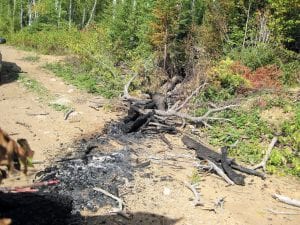Photos by Ranger Bob Maki While inspecting a timber sale near Thompson Lake in Grand Marais, Minnesota Department of Natural Resources (DNR) Forester Bob Maki discovered this single white pine that was apparently struck by lightning sometime between September 9 and September 15. US Forest Service crews visited the site to ensure that fire was not smoldering at the root base. USFS East Zone Resource Coordinator Tom Westby said high humidity and moisture apparently prevented the fire from spreading.

Lightning strike fires are more common than Northland residents may think. This burned white pine was discovered by Minnesota Department of Natural Resources (DNR) Forester Bob Maki when he was making a visit to a timber sale near Thompson Lake in Grand Marais. Maki knew from his visit log that the lightning strike had occurred sometime between September 9 and when he discovered it on September 15. Maki contacted the US Forest Service, which immediately sent a crew to ensure that fire was not still smoldering at the root base. USFS Superior National Forest East Zone Resource Coordinator Tom Westby said no suppression was necessary. High humidity and moisture apparently prevented the fire from spreading.
Westby said it is not known how often this occurs in the forest. “In any given season there are thousands of lightning strikes and only a handful of fires that need suppression,” he said in a phone interview the day after the discovery.
“I’m sure there is a high percentage of fires that burn themselves out. The woods are pretty big and if we don’t see smoke, we can’t do anything about it,” said Westby.
The Forest Service has three Beaver aircraft that conduct almost daily flights over the entire Superior National Forest, depending on the weather. If it rains flights may not be needed, however if conditions are hot and dry, Westby said the Beavers may fly twice or even three times a day. If someone calls in a report of smoke, Westby requests a fly-over and sends a ground crew. If smoke and/or fire is found, the pilot guides the fire crew on the ground.
For up-to-date fire danger information, visit the MN DNR website at www.dnr. state.mn.us/forestry/fire or call the Forest Service at the Gunflint Ranger Station at (218) 387-1750 or Tofte Ranger Station at (218) 663-7280.


Loading Comments